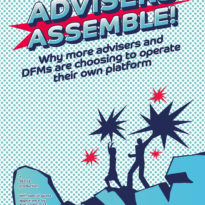The promise and excitement around setting up your own outsourced paraplanning firm is not always matched by the reality. Fiona Bond talked to two experienced paraplanners about the challenges they faced and how they overcame them
The virtues of setting up your own business are well known – not least independence, greater flexibility and personal fulfillment – but becoming a business owner also brings with it a number of obstacles and challenges.
Making the leap from employee to business owner requires paraplanners to assume new, and often unfamiliar, roles. From marketing and IT to people management and compliance, it can be a daunting prospect.
Aleksandra Sasin founded her own business, Navigatus, in November 2017 and says the early days were a bigger learning curve than she had expected.
“I felt I had gone into the process with my eyes completely open but no amount of research can thoroughly prepare you. I underestimated the time I would need to devote to the actual running of the business, which takes you away from doing what you truly love – paraplanning – and the amount of time I would need to work without being paid for it.”
And while Sasin never felt overwhelmed when starting out, she admits she did feel uncomfortable at points.
“When you’re working for yourself, you just have to get on with it because you have no other choice. But in hindsight, you realise just how time-consuming and intense it was. You have to be prepared to make mistakes and be kind to yourself, as you will learn from those mistakes.”
Setting aside valuable time for managing the business, which could otherwise have been spent working with clients, can be a juggling act for new businesses. In addition, paraplanners also need to factor in time for networking and CPD events, all of which count as “non-billable” hours.
To help ease the pressure, Rebecca Lucas, founder of Lime Outsourced Paraplanning, says a savings buffer was key in setting up her own business.
“Having savings in place before quitting your job and setting up on your own will massively take the pressure off and means you can still cover your salary and overheads if work goes quiet,” she says.
“Also don’t underestimate the initial set up and ongoing monthly costs in running a business, including software, accountancy fees, professional fees and IT.”
Building a client base
According to Lucas, managing the ups and downs of her workload was one of the hardest parts of running her own business.
“For me, it was very much feast or famine in the first year; I had times when I was working day and night and then also times when there wasn’t any work coming in, where I sat at my desk wondering if I’d ever get another piece of work,” she says.
While being unsure of when the next job is coming in can be challenging, Lucas admits it was also problematic when there was too much work and not enough hours in the day.
She explains: “It takes a while to build up a good client bank. In the early days, you end up working with anyone and everyone who asks and this can be hard but I feel it’s an important step as you learn who your ideal client is and isn’t.
“Now we know who our ideal clients are and we are in the fortunate position of working with people who fit the ideal. This all comes with time and sadly, you can’t speed up the process, you have to go through the hard times, learn from any mistakes and don’t give up.
“My advice to people is to go easy on yourself in the first year as workflow and cashflow is likely to be up and down.”
Fortunately, Lucas met her first client at her CII graduation ceremony, which she attended on the first day of running her own business. While she tried advertising in the early days, it didn’t have the desired effect.
She continues: “I think the old cliché is true and people buy people. Lots of my work then and today comes from word of mouth, often people I already know come to me for paraplanning or refer people to me.
“But being a great paraplanner isn’t enough if you’re starting out alone. You have to think about marketing and sales and enjoy that side of things. You need to always have marketing in mind as it’s natural to lose clients as you go along so you need to be able to replace them.”
Sasin agrees that building a client base can be one of the biggest hurdles when starting a business, but like Lucas, was able to rely on professional connections.
“The first client is undoubtedly the most difficult but we work on a referral basis which I prefer. There is an instinct to take on anyone when you first start out to ensure you have an income, but you need to be very clear about the type of client you want to work with. Our clients have remained with us because we have chosen so carefully,” she says.
Managing time
Flexibility is often cited as an advantage of being your own boss but it can also be a challenge striking the right balance in the early days of starting a business.
For Sasin, the expectation that she would have more freedom and greater flexibility proved not to be the case.
“I found, especially in the early days, that any extra pockets of time I had went to business functions like setting up the website. As a new business owner, you are a lot slower and everything takes a lot longer.”
Managing the expectations of family and friends was also a challenge.
She explains: “Working for yourself means it can be hard to switch off and you need to explain to those around you that you won’t be available as much as they might like or expect. I work evenings, weekends and even with holidays, I never fully switch off.
“When you’re starting out, you feel that clients expect you to be there constantly and you worry about taking time off. The key is to manage people’s expectations so no one is disappointed.”
Ongoing challenges
Sasin has grown her business over the past two years to employ three other members of staff. But as the business grows, different problems and challenges demand a new approach.
“If you choose to take on staff, you have the responsibility of people management which might not come naturally to you. The challenge now is that the decisions I make no longer just impact me. It’s a process of constant education and learning. It doesn’t become easier or more difficult, just different, and you need to adjust to those changes,” she says.
Now responsible for a team, Sasin says it helps to share ideas and problems with other business owners.
“There is a huge difference between being a freelance outsourced paraplanner and running your own business,” she explains. “In running a business, paraplanning almost becomes secondary. That’s why it’s so important to have a network of people you can talk to, share experiences with and hear how they overcame certain challenges.
“I was never very good at asking for help but owning my own business has taught me to overcome that. I’m grateful that the paraplanning community as a whole is incredibly supportive of one another.”
You can find out more about Navigatus at https://navigatus.co.uk and Lime Outsourced Paraplanning at http://www.outsourcedparaplanner.co.uk




























